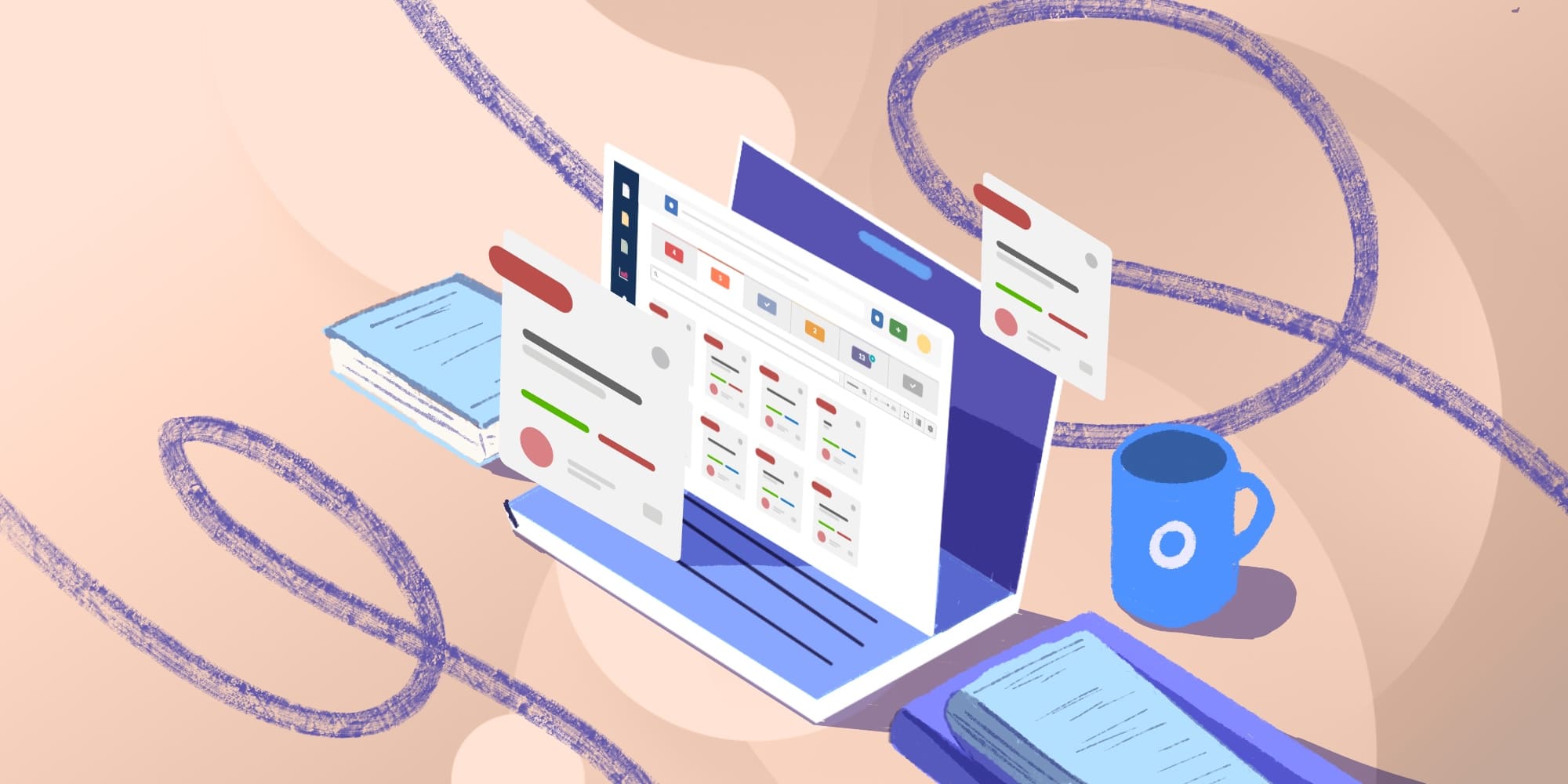Service desk software is one of your most important investments as a service-focused organization. To provide high quality IT support, leaning into IT Service Management (ITSM) is an essential first step. However, a solid ITSM strategy must be backed up by a robust tool.
By automating operations and making communication more effective, an ITSM solution will help increase end-user engagement while also making the support agent's job easier.
In this thorough guide you will find the key features and capabilities to look for when choosing your service desk solution. We have also put together our top fourteen picks for you to compare.
Let's get into it!
We tried to be as thorough as possible, but if you don't have enough time to read it through and through, here's (another) TL;DR: InvGate Service Desk can do everything we say here, and you can test it right away for free for 30 days.
Table of contents
- TL;DR
- How to choose the right service desk software
- Service desk solution features and capabilities
- Types of service desk tools
- 14 best service desk software
- Service desk tool comparison
- 6 benefits of service desk software
TL;DR
- Service desk software constitutes a crucial tool to purchase.
- Businesses use it to manage employee and customer requests, automate repetitive tasks, and digitally transform the entire organization.
- Service desk tools should be intuitive enough to be used by multiple departments other than IT.
- Among its main features, we can count self-service options, Incident and Problem Management, automation, reporting and AI capabilities.
How to choose the right service desk software?
Since service desk software is one of the most crucial purchases an IT support team can make, selecting the right ITSM tool is key. Done well, ITSM practices can improve service performance, increase customer satisfaction, and reduce risk. So, the stakes are pretty high.
Buying a new service desk tool is not a task you should do in isolation, so build a team around you to get a balanced and comprehensive view of requirements and technical specifications.
Some of the things to consider include:
- Scope - You need to agree on the required scope of your tool and ensure that the solution you pick meets your overall objective. Consider which process and functions you need the tool to cover and then plan accordingly.
- Requirements gathering - Care must be taken to ensure the product works for your organization. If you're used to the ITIL framework, then the MoSCow analysis can be helpful.
- Procurement - A service desk tool is a significant investment, so get help from your Finance or Procurement team. Even if you're switching service desk suppliers rather than buying a brand new toolset, there are still switching costs to consider, so ensure the relevant teams guide you.
- Technical requirements - This is less of a concern if you go down the SaaS route, but things to double-check include the following:
- Key functionality and how it could work in your environment.
- How, as a client, you would be able to ensure your estate has the appropriate coverage.
- How the tool recognizes when new services are added to the production environment.
- How the tool deals with duplicate records or identifies offline or inactive assets.
- How the tool manages virtual environments and cloud-based services.
- If the tool can import data from multiple sources, for example, HR data or system information from Active Directory or FreeIPA (other directory databases are available).
- What support is in place for enterprise IT Asset Management (ITAM), for instance, handling multiple business units, cost codes, or geographic locations.
- Speed of implementation - The last thing you want is a lengthy, drawn-out implementation. You can speed up the process with our ITSM implementation checklist and these tips on speeding up the migration process.
- Go live - Make sure you have the appropriate support when implementing the tool. Does the vendor provide early life support or free consultancy around going live? As part of the negotiation process, have the vendor walk you through a typical new implementation so there are no surprises when you launch your tool for the first time.
- On-going support - Things to consider: upgrades, legacy applications, and custom integrations. If your tool is SaaS-managed, then the upgrade path should be maintained, but you still need to consider how integrations with custom software or legacy applications are supported. Ask to see case studies or sample customer sites to see how other companies manage support for custom or nonstandard integrations. It's good practice to have visibility of customers with similar needs, allowing functionality to be shared in some cases.
Before you make a final decision, make sure you can answer the following questions:
- How will the tool vendor help you to up your organization's ITSM game?
- Will they be able to assist in the delivery of new best practice practices?
- How configurable/customizable is the tool? What works now may need to be adapted in a year, so factor in how easy it is to make changes. Look for no-code/low-code to make changing proms and workflows easier.
- How is the upgrade path managed? How does the tool vendor assist with changes and new releases? Are patches available in a continuous delivery model, or is the process more manual?
- How does the vendor intend to stay relevant? How poised are they to evolve with the market?
- Does the company offer new ideas and innovations, or are they more about improving your core service desk offerings and ITSM processes? There is room for improvement, but it's good to know early on.
Service desk solution features and capabilities
Regardless of your choice, your go-to option has to meet specific capabilities and offer you some essential features. Let's take a look at them.
Service desk software's must-have features
Make sure that your service desk tool covers these must-have features:
- Automation
- Self-service portal
- Incident Management
- Request Management
- Service catalog
- Knowledge base
- IT asset database
Service desk software capabilities
In addition, these service desk software capabilities will make your life much easier:
- No-Code/Low-Code - Codeless doesn't always mean zero code needed, ever (although that would be nice). Some vendors sell tools that purport to be codeless but still require scripts or commands to be entered to perform administrative tasks or make certain configuration settings. Other vendors sell codeless products only available as a cloud or SaaS-based proposition, limiting installation options. Simply put, to be genuinely codeless, the entire product should be fully customizable without requiring Java, C++, and Visual Basic. This significantly reduces costs and delivery time, as well as reduces downtime during maintenance windows.
- Modern UX - Customers are used to the experience generated by Amazon, Google, and Facebook, so your service desk tool needs to be easy to engage with.
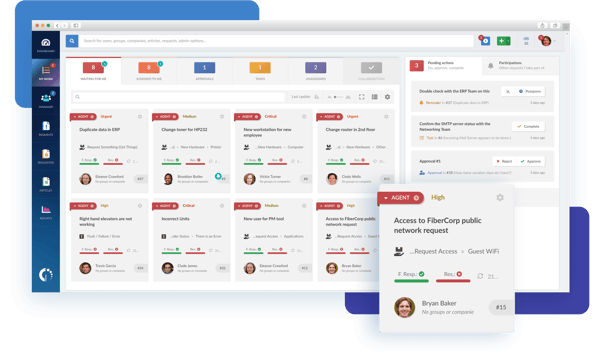
- API integrations - ITSM tools rarely work in isolation. When reviewing them, check how they integrate with third-party applications so that you can link them to your organization's technological landscape – such as the HR system, to make the new hire process easier. If your ITSM tool has these connections in place through a direct link, custom APIs, or shared data, you will streamline ticket management and data capture.
- Automation, AI, and bots - Virtual agents or digital assistants providing solutions drawn from data models and previous interaction history facilitate self-service and a consistent user experience.
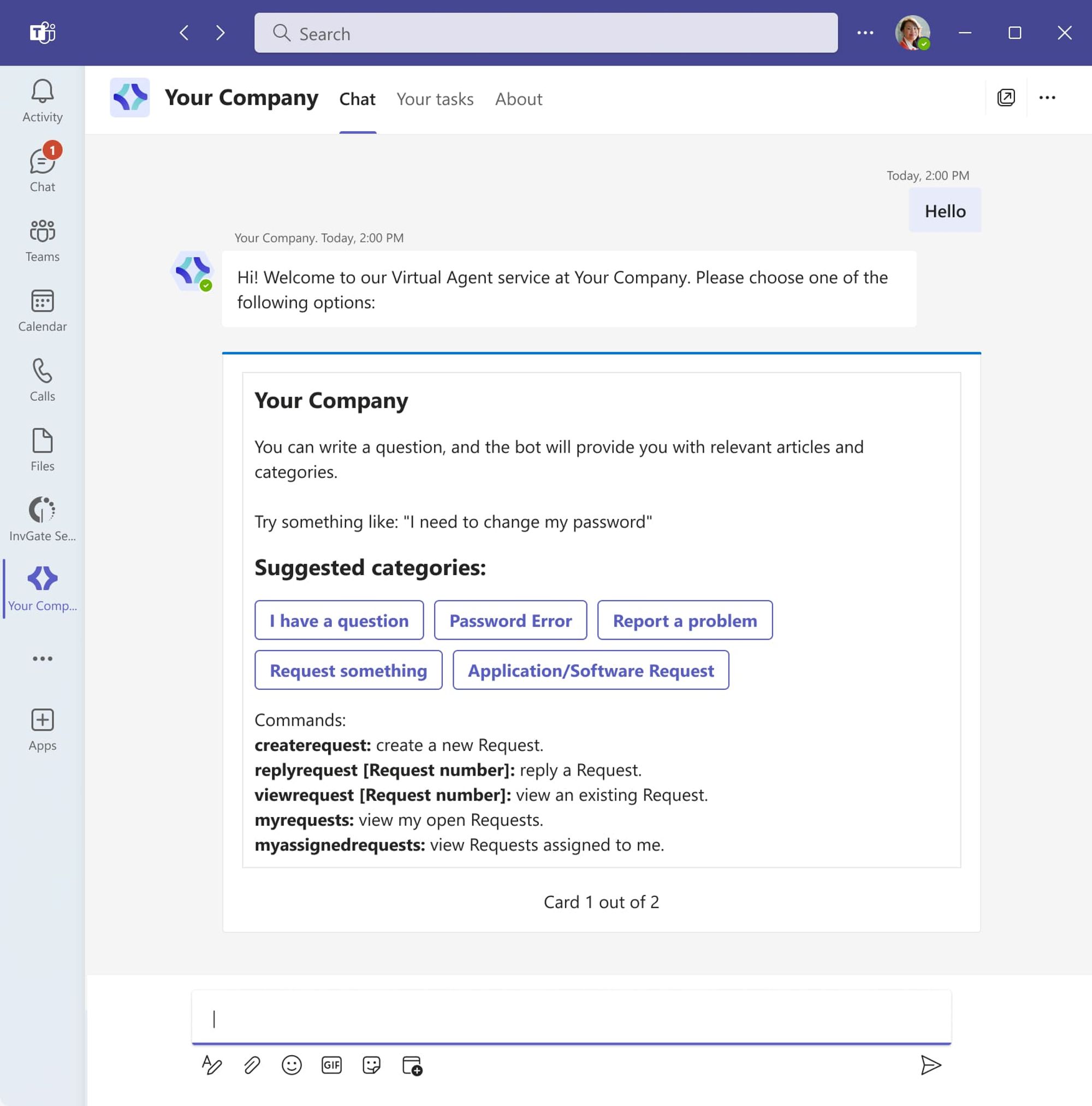
- Incident, request, and change capture forms - These should be easy to engage with and easy to use.
- Reusable workflows - This aims to facilitate Enterprise Service Management by deploying one workflow elsewhere in the organization.
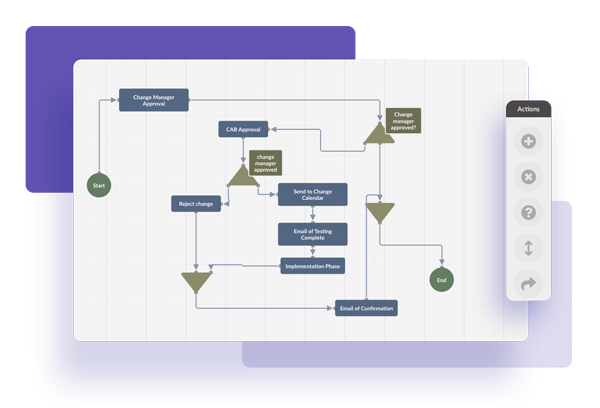
- Continuous deployment and pull-based delivery mechanisms - This will help you manage the update path.
Send a service desk RFP to review available features
Numerous organizations rely on request for proposals (RFP) to get deeper insights into a potential vendor's offered features and capabilities. In general, they list the company's needs and priorities, leaving room for shortlisted vendors to explain if and how they fulfill each item.
This practice has a double benefit. On the one hand, organizations access specific details to understand how specific software will accommodate to their situation. And on the other hand, it allows them to compare software alternatives using the same criteria.
If you want to give them a go, you don't need to start from scratch! You can download our service desk RFP template and adapt it to your business.
Types of service desk tools: cloud vs. on-premise
A question still dominating many ITSM discussion forums is which is better, cloud or on-premises solutions? The answer for most organizations is: it depends.
Pros and cons of on-premise solutions
A considerable percentage of customers still prefer to use on-premise software. Some of its benefits include the following:
- Control - With on-premises, you have complete autonomy over the service, its data, and who can access it.
- Ownership - You deploy and run the software, maintaining that overall span of control.
- Data protection - Some organizations will have data protection requirements to satisfy regulatory authorities. Opting for on-premise software keeps all your data in your environment without outside access.
On the contrary, using on-premise software may not be suitable for your business because of the following:
- Installation and maintenance - On-premise software can be time-consuming to install and maintain.
- IT support overheads - You will need local IT support to run and maintain services if you have on-premises software.
- Increased maintenance costs - With on-premises solutions, you must purchase servers and other supporting hardware to keep the software running effectively.
- Increased risk of data loss - Our data is everything, and with on-premises storage, a backup glitch, hardware failure, or security threat could cause you to lose your data.
- Performance issues - Pressure on the hardware can cause performance issues as and when the number of endpoints increases, placing strain on the existing infrastructure.
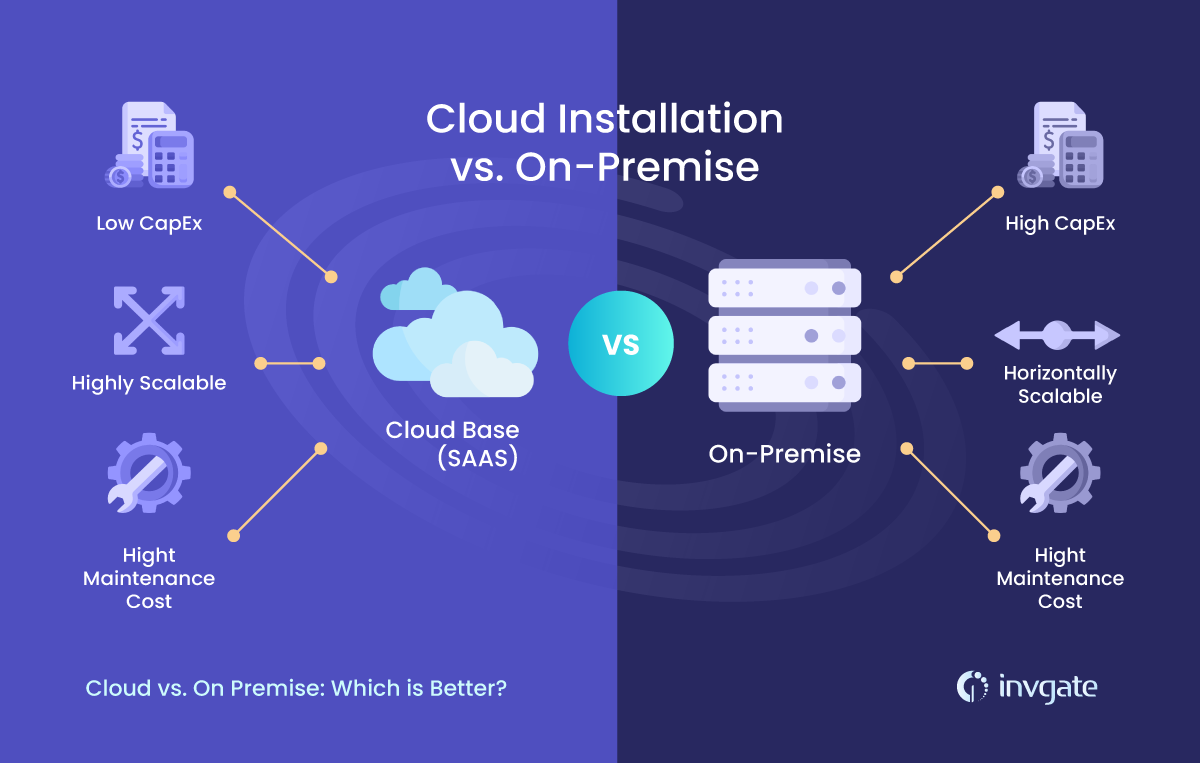
Benefits of cloud service desk solutions
Cloud-based ITSM software, on the other hand, is externally hosted and maintained by the ITSM tool vendor. Cloud solutions have plenty of benefits, including:
- Increased flexibility and scalability - Cloud-based solutions can flex with the business and scale up as required without the need for additional hardware or complicated software deployments.
- Lower costs - With SaaS solutions, everything needed to run and maintain the service is included in the subscription, so there is no scope creep or hidden fees.
- Better performance - Lack of reliance on physical hardware means that performance is high-speed and consistent across all endpoints.
- Automated updates - Updates are rolled out automatically with cloud-based solutions and installed faster than in an on-premises environment.
14 best service desk software
The service desk software arena is crowded. There are about 42 competitors in the ITSM market nowadays, but here, we'll summarize the leading players.
1. InvGate Service Desk
InvGate Service Desk overview
|
|
InvGate Service Desk is a comprehensive solution for the effective, efficient, and safe running of IT operations. With it, you can perform many tasks, as it comes packed with the following:
- Ticketing Management.
- 7 ITIL-certified functionalities.
- Reporting and customizable dashboards.
- Workflow automation.
- Service Level Management.
- Native integration with Asset Management.
- Self-service capabilities such as portal, service catalog, and knowledge base.
- Gamification.
- Omnichannel support.
- AI-powered features (such as Support Assist and Response Suggestions).
Thanks to its intuitive interface, it's perfect for expanding beyond IT and adapts perfectly to all types of organizations.
For example, with InvGate Service Desk, Harmony Public Schools unified 58 schools around Texas and saw a 300% increase in fulfilled service requests and a 71.5% improvement in resolution, wait, and response times.
When asked what makes the tool stand out, Martin Nuñez, Service Desk Manager, highlighted its customization capabilities and intuitive interface. His favorite features are "tracking in the request log, the simple interface, especially for the end user, and the ability to make templates or forms within certain categories of service."
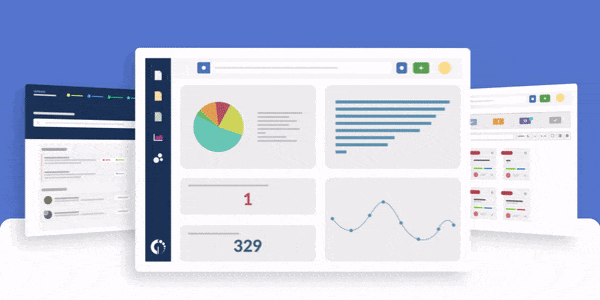
InvGate Service Desk's key advantages
- InvGate isn't just a ticketing system; it's a comprehensive ITSM solution with built-in ITAM and Enterprise Service Management (ESM) functionality.
- A 30-day free trial period and a live demo are available to try before you buy.
- Offers both on-premises and cloud implementation options.
- Integration and support costs are included.
We tried to be as thorough as possible, but if you don't have enough time to read it through and through, here's (another) TL;DR: InvGate Service Desk can do everything we say here, and you can test it right away for free for 30 days.
2. Cherwell/Ivanti
Cherwell overview
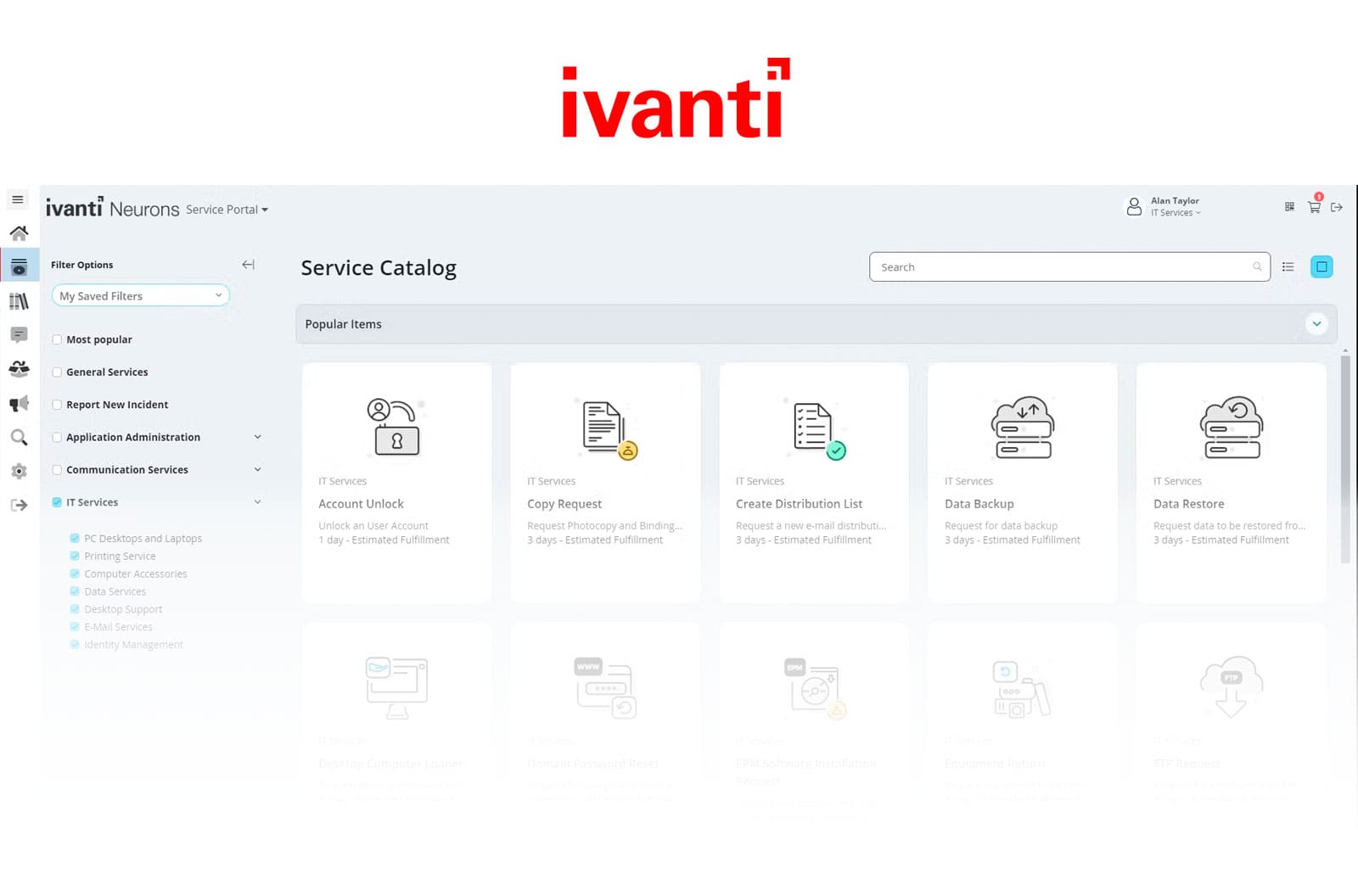
Cherwell Service Management (acquired by Ivanti) is a mid-market service desk solution verified for eleven ITIL processes. It provides IT organizations the flexibility required for rapid configuration and customization, minimal overhead, and frictionless upgrades.
Cherwell advantages
- Pre-built line of business solutions for ESM.
- Codeless configuration.
- Discovery and dependency mapping.
- Support for omnichannel engagement.
- Complete visibility and automated CMDB updates for more effective IT operations.
- It can be extended using mApps (merge-able applications) from the Cherwell Marketplace.
However, mentioning that it's secondary to the Ivanti solution is relevant, and ITAM is only available as a separate module.
Cherwell alternatives
- Cherwell vs. Ivanti Neurons
- Cherwell vs. ServiceNow
- Cherwell vs. Freshservice
- Cherwell vs. ManageEngine
- Cherwell vs. Jira
- Cherwell vs. SolarWinds
- Cherwell vs. Aranda Service Management
- Cherwell vs. BMC Helix
- Cherwell vs. TOPdesk
- Cherwell vs. SysAid
- Cherwell vs. Zendesk
- Cherwell vs. SymphonyAI Summit
- Cherwell vs. EasyVista
3. Hornbill
Hornbill overview
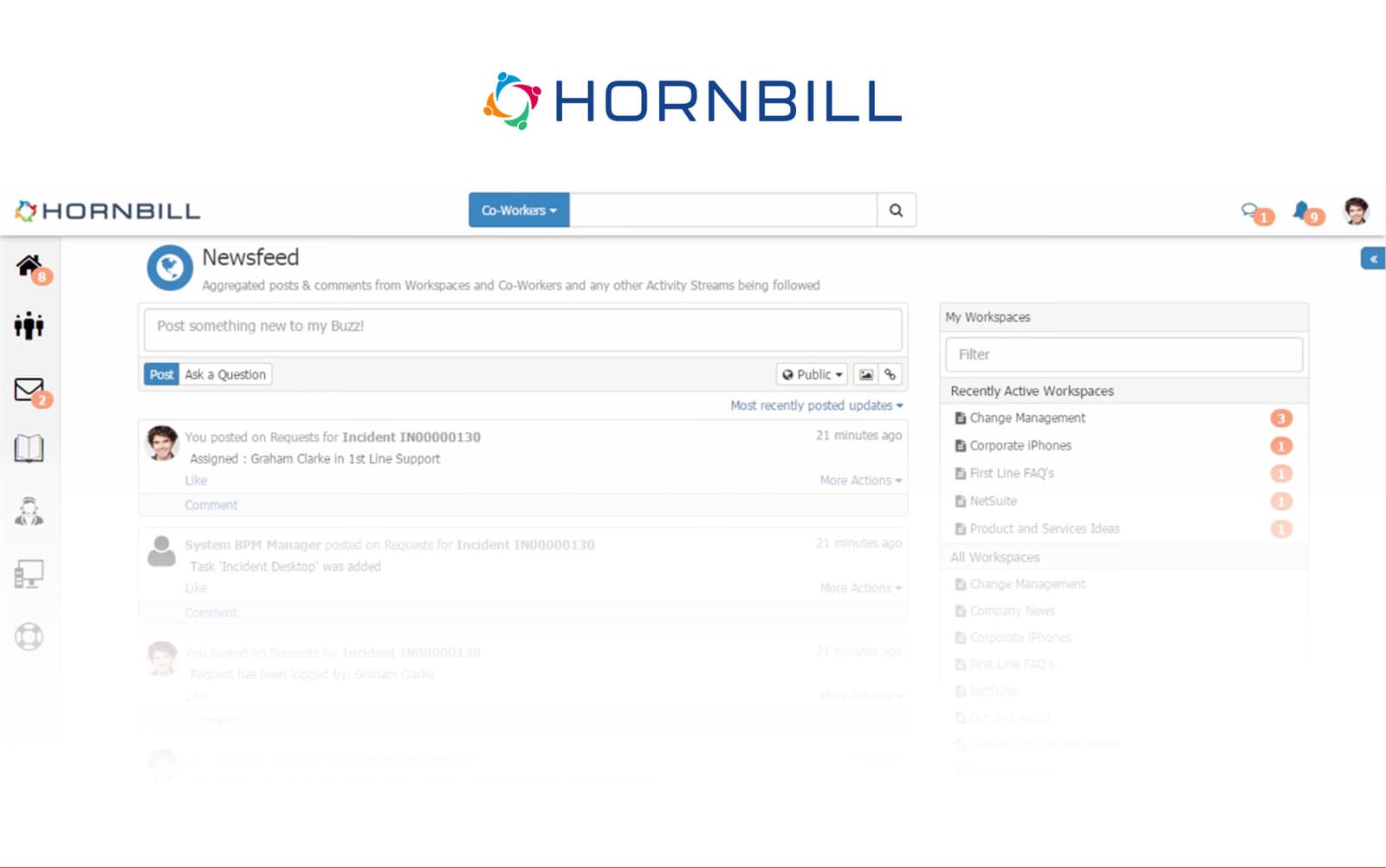
Hornbill's service desk software offers users a 100% codeless environment with out-of-the-box workflows and a focus on automation. It has "elastic licensing" to add or remove licenses easily and a configurable CIO dashboard with real-time status information and emerging trends.
Hornbill advantages
- Cloud-based ITSM, so there's no app management or hosting required.
- Codeless configuration.
- Strong automation capabilities.
4. ManageEngine
ManageEngine overview

ManageEngine offers service and asset management capabilities to small, midsize, and large enterprises. Some of its distinctive features are ITSM workflows, smart automation, integration access to a wide variety of applications, and ESM capabilities.
ManageEngine advantages
The most distinctive pros of ManageEngine are:
- A fully-customizable self-service portal supported by a service catalog.
- A three-tier plan for customers.
- Support for project management tasks.
ManageEngine alternatives
- ManageEngine vs. ServiceNow
- ManageEngine vs. Cherwell
- ManageEngine vs. Ivanti Neurons
- ManageEngine vs. Jira
- ManageEngine vs. Freshservice
- ManageEngine vs. SolarWinds
- ManageEngine vs. Aranda Service Management
- ManageEngine vs. BMC Helix
- ManageEngine vs. TOPdesk
- ManageEngine vs. SysAid
- ManageEngine vs. Zendesk
- ManageEngine vs. SymphonyAI Summit
- ManageEngine vs. EasyVista
- ManageEngine vs. TeamDynamix
5. SysAid
SysAid overview
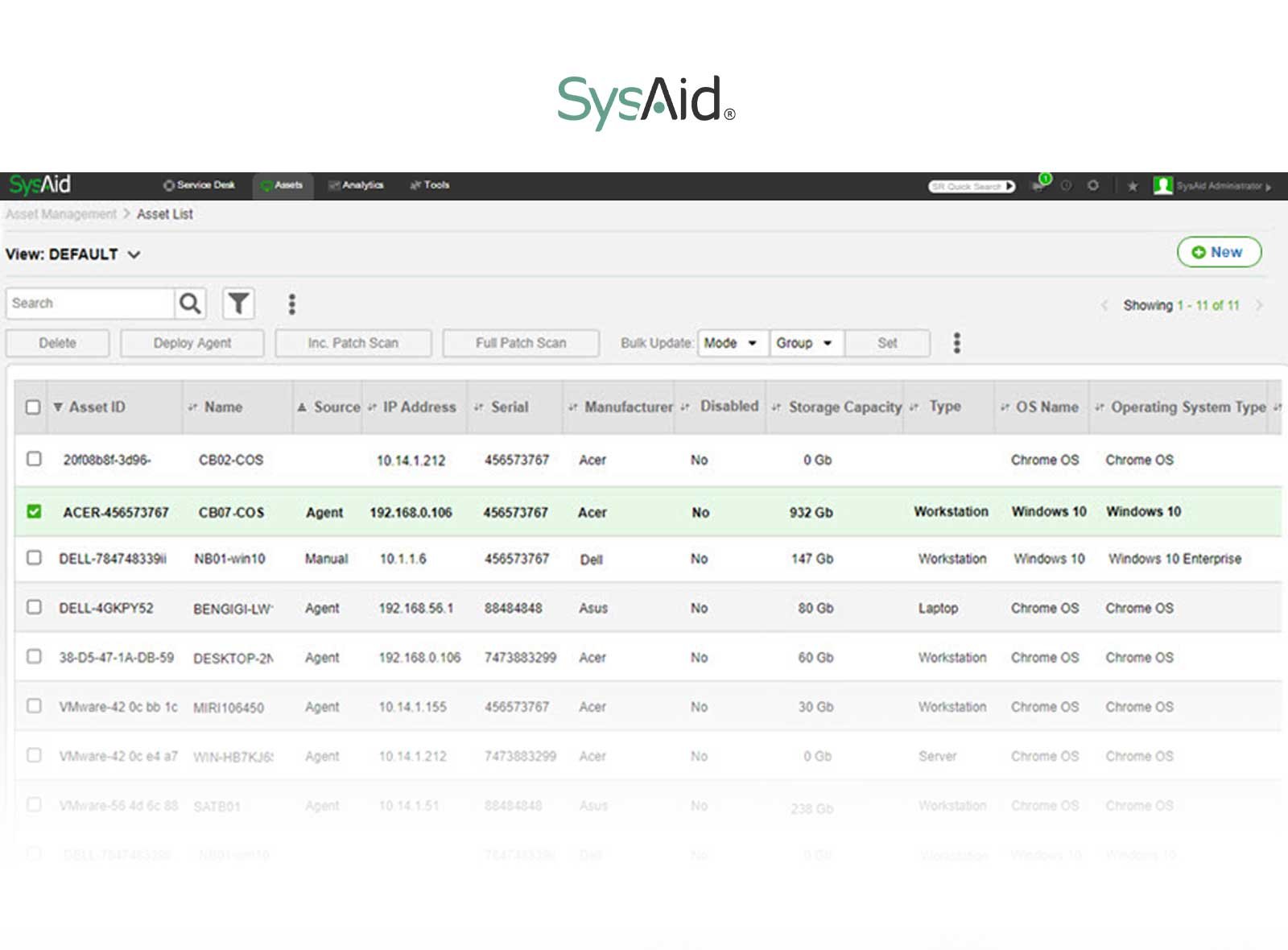
Best suited to small and medium-sized organizations, service automation is the key offering in SysAid's cloud service desk solution. It offers help desk and asset management capabilities, third-party integrations, and fast implementation.
SysAid advantages
SysAid's solution stands out because:
- It offers out-of-the-box Request, Change, and Problem Management capabilities.
- It has a tight focus on Incident, Problem, Request, and Change Management.
However, it has no pre-built ESM line of business capabilities.
SysAid alternatives
- SysAid vs. SolarWinds
- SysAid vs. ServiceNow
- SysAid vs. Aranda Service Management
- SysAid vs. BMC Helix
- SysAid vs. TOPdesk
- SysAid vs. Freshworks
- SysAid vs. Ivanti Neurons
- SysAid vs. Jira
- SysAid vs. Cherwell
- SysAid vs. ManageEngine
- SysAid vs. Zendesk
- SysAid vs. SymphonyAI Summit
- SysAid vs. EasyVista
6. Freshservice
Freshservice overview
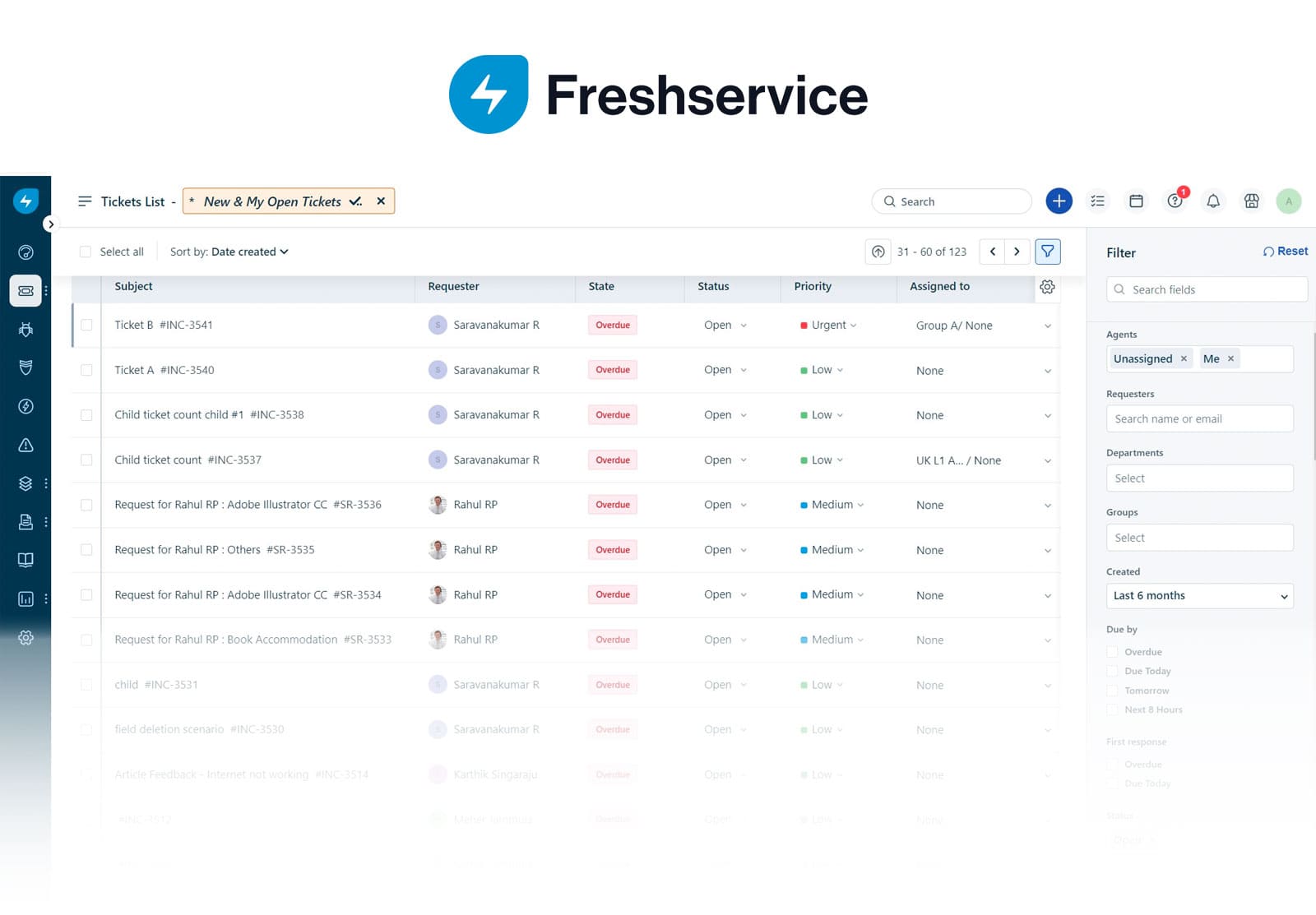
Freshservice is a cloud-based ITSM and service desk solution serving SMBs, mid-market, and larger organizations. It promises robust automation, rapid deployment, and monthly updates to the solution.
Freshservice advantages
- Automation and virtual agents
- Focus on Incident, Problem, Change, Release, Asset, and Configuration Management
- Intuitive self-service
Freshservice alternatives
- Freshservice vs. ServiceNow
- Freshservice vs. Jira
- Freshservice vs. Ivanti Neurons
- Freshservice vs. Cherwell
- Freshservice vs. ManageEngine
- Freshservice vs. Zendesk
- Freshservice vs. SolarWinds
- Freshservice vs. Aranda Service Management
- Freshservice vs. BMC Helix
- Freshservice vs. TOPdesk
- Freshservice vs. SysAid
- Freshservice vs. SymphonyAI Summit
- Freshservice vs. EasyVista
- Freshservice vs. TeamDynamix
7. BMC Helix ITSM
BMC Helix overview

BMC Helix ITSM replaces BMC Remedy and is a broad suite of ITSM tools offering a wide range of integrations to other BMC tools and in-built ITAM. The product is used mainly by global brands and markets itself.
BMC Helix advantages
- Long track record of ITSM service provision.
- Operations Management for monitoring and configuration.
- History of large enterprise success.
- Strong alignment with ITIL 4.
- Cognitive email analysis and automated actions on behalf of the user.
It's important to mention that the solution doesn't have a "lite" option, so that it might be expensive for some businesses. In line with this, it has a complex implementation.
BMC Helix alternatives
- BMC Helix vs. ServiceNow
- BMC Helix vs. Solarwinds
- BMC Helix Aranda Service Management
- BMC Helix vs. Ivanti
- BMC Helix vs. Cherwell
- BMC Helix vs. Jira
- BMC Helix vs. ManageEngine
- BMC Helix vs. TOPdesk
- BMC Helix vs. SysAid
- BMC Helix vs. SymphonyAI Summit
- BMC Helix vs. EasyVista
8. ServiceNow
ServiceNow overview
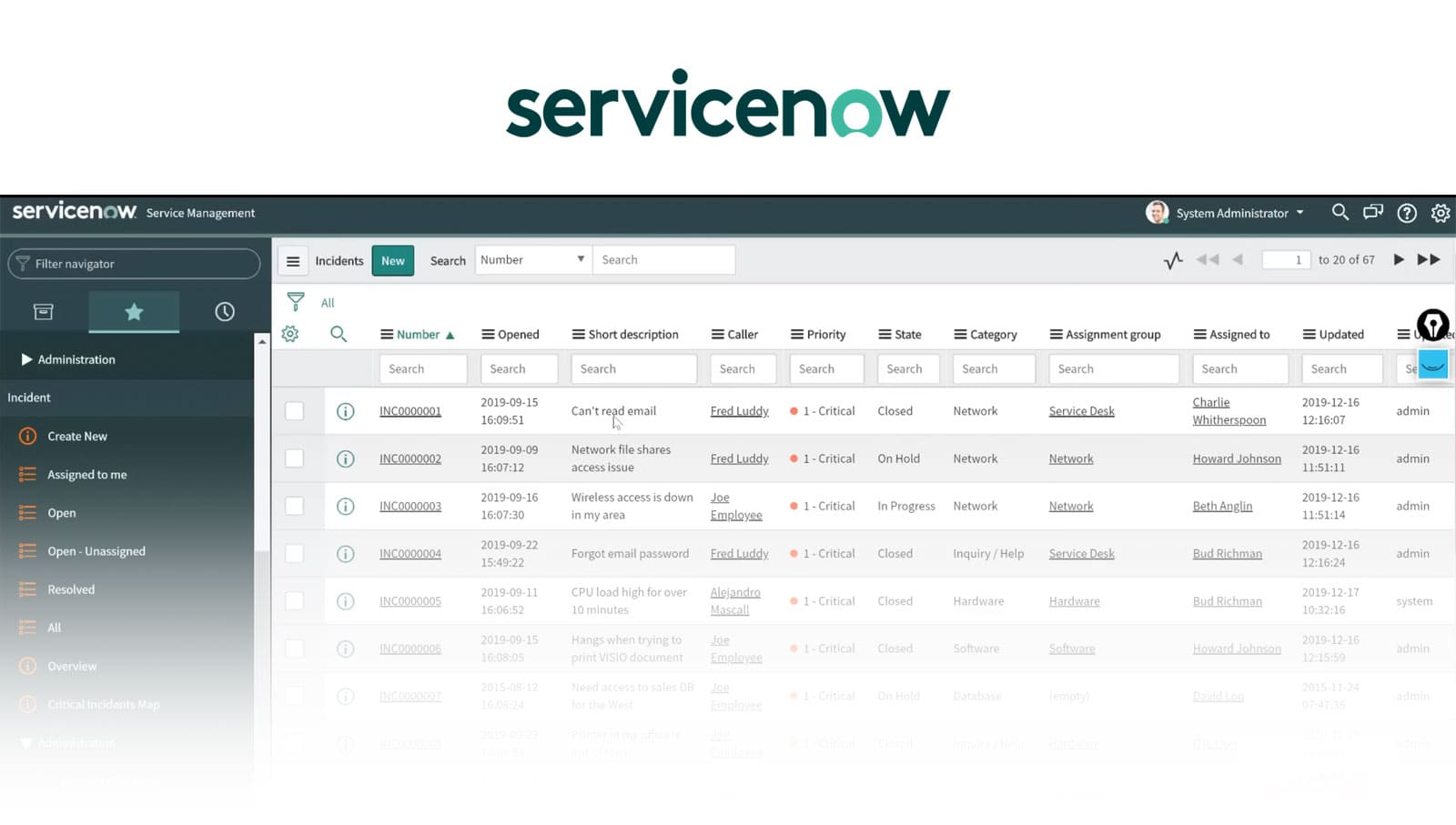
Built on the ServiceNow Now Platform, its ITSM bundle provides an agent workspace with Knowledge Management and modules supporting Incident and Problem Management, as well as Change, Release, and Configuration Management. ITAM capabilities are also offered on the higher-tier ITSM Professional plan.
ServiceNow advantages
- It's generally regarded as one of the industry-leading ITSM solutions.
- Platform features.
- Pre-built ESM solutions.
- Automation and AI investments.
- Experience-focused design.
Same as with BMC, ServiceNow doesn't have a low-budget option.
ServiceNow alternatives
- ServiceNow vs. ManageEngine
- ServiceNow vs. Freshservice
- ServiceNow vs. Ivanti Neurons
- ServiceNow vs. Cherwell
- ServiceNow vs. Jira
- ServiceNow vs. SolarWinds
- ServiceNow vs. SysAid
- ServiceNow vs. BMC Helix
- ServiceNow vs. TOPdesk
- ServiceNow vs. Aranda Service Management
- ServiceNow vs. Zendesk
- ServiceNow vs. SymphonyAI Summit
- ServiceNow vs. EasyVista
- ServiceNow vs. TeamDynamix
9. Marval
Marval overview

Available on-premises or as a SaaS solution, Marval is an ITIL-aligned service desk tool that has been available for over 30 years. It has a heavy focus on Enterprise Service Management.
Marval advantages
- Use of automation and machine learning to streamline and automate routine interactions.
- Combines data lakehouse technology, artificial intelligence (AI), machine learning (ML), and robotic process automation with ITSM in one platform.
- Recent investment in AI-assisted problem management.
10. Jira Service Management
Jira Service Management overview

Jira Service Management (formerly Jira Service Desk) provides everything IT and support teams need out-of-the-box for Service Requests, Incident, Problem, and Change Management. It focuses on high-velocity support, integrates with Slack and Trello, and offers a mobile app for flexibility.
Jira Service Management advantages
- It has an intuitive self-help portal.
- It offers a free option for up to three agents, which means you can try the product free of charge.
It's worth noting that Jira is currently moving away from on-premise alternatives.
Jira Service Management alternatives
- Jira Service Management vs. Freshservice
- Jira Service Management vs. ServiceNow
- Jira Service Management vs. Ivanti Neurons
- Jira Service Management vs. Cherwell
- Jira Service Management vs. ManageEngine
- Jira Service Management vs. SolarWinds
- Jira Service Management vs. TOPdesk
- Jira Service Management vs. Aranda Service Management
- Jira Service Management vs. BMC Helix
- Jira Service Management vs. Zendesk
- Jira Service Management vs. SymphonyAI Summit
- Jira Service Management vs. EasyVista
- Jira Service Management vs. TeamDynamix
11. TOPdesk
TOPdesk overview
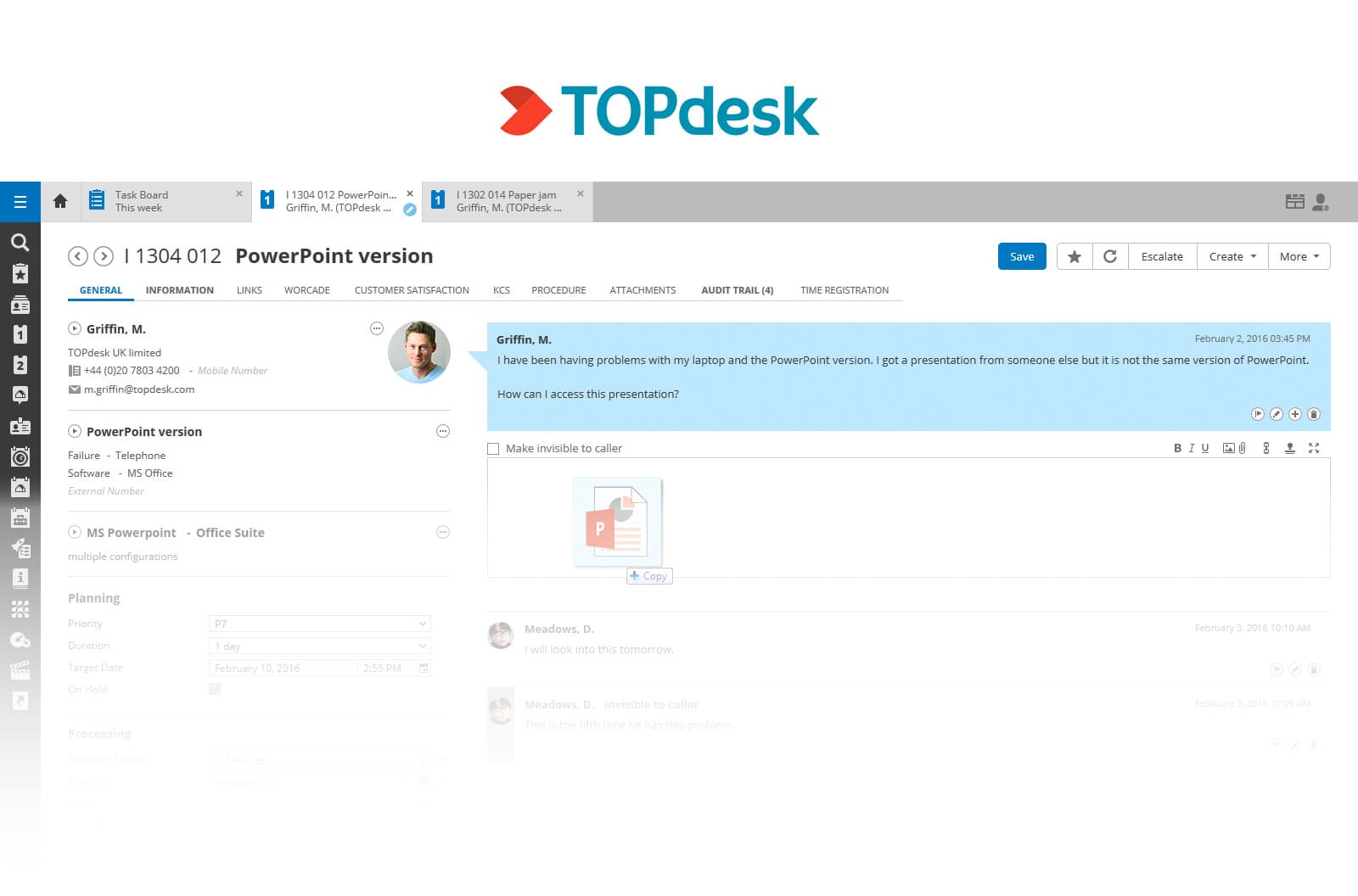
With on-premises and SaaS deployments available, TOPdesk's ITIL-aligned solution comes out of the box without coding. It has a solid European presence, is an early ESM proponent, and offers support for computer-aided facilities management (CAFM).
TOPdesk advantages
- Configured to individual requirements, select the plan closest to your needs and then supplement with add-ons.
- Well suited for ESM.
- Supplier management.
12. EasyVista
EasyVista overview

EasyVista's ITSM solution is aimed at enterprise organizations and offers codeless configuration, smart automation, and out-of-the-box ITIL processes. It has a user-centric interface and supports core ITSM practices. In addition, it's important to mention that it focuses on maturity rather than complexity.
EasyVista advantages
- Strong customer relationships.
- Flexibility.
- Knowledge Management investments.
EasyVista alternatives
- EasyVista vs. SymphonyAI Summit
- EasyVista vs. Jira Service Management
- EasyVista vs. ServiceNow
- EasyVista vs. Freshservice
- EasyVista vs. ManageEngine
- EasyVista vs. Ivanti Neurons
- EasyVista vs. Cherwell
- EasyVista vs. SolarWinds
- EasyVista vs. Aranda Service Management
- EasyVista vs. SysAid
- EasyVista vs. BMC Helix
- EasyVista vs. TOPdesk
- EasyVista vs. TeamDynamix
- EasyVista vs. Microsoft System Center Service Manager
13. SolarWinds Helpdesk
SolarWinds Helpdesk overview
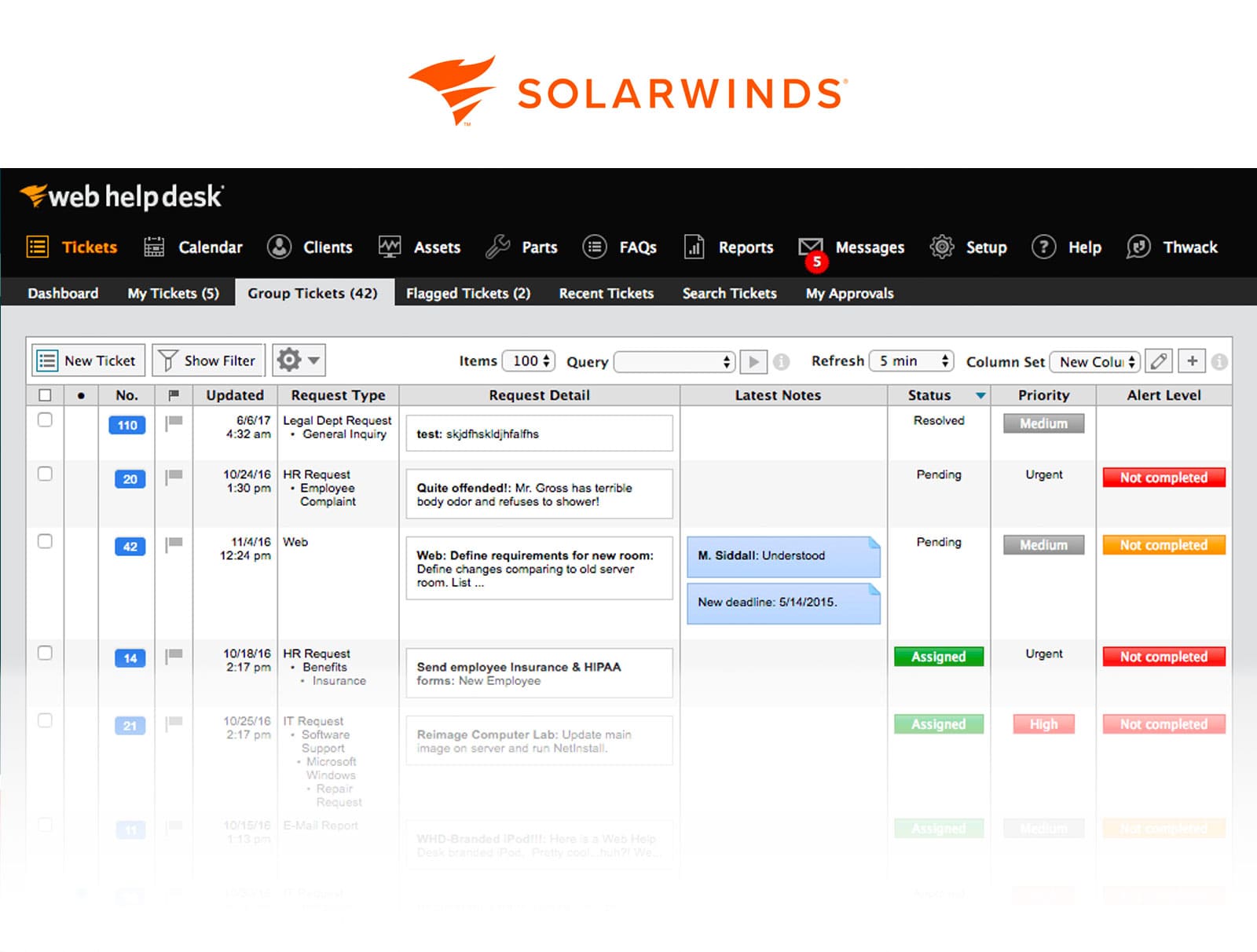
SolarWinds offers a relatively simple, easy-to-use service desk solution that adheres to ITIL's best practices. Since it's essentially a help desk, it's best suited to smaller organizations. It offers a fully functional free trial available to use for 14 days.
SolarWinds Helpdesk advantages
- Simple, efficient ticketing system.
- Centralized knowledge base.
- Integration with AD and LDAP.
SolarWinds Helpdesk alternatives
- SolarWinds vs. ServiceNow
- SolarWinds vs. ManageEngine
- SolarWinds vs. Freshservice
- SolarWinds vs. Ivanti Neurons
- SolarWinds vs. Jira Service Management
- SolarWinds vs. SysAid
- SolarWinds vs. BMC Helix
- SolarWinds vs. Cherwell
- SolarWinds vs. Aranda Service Management
- SolarWinds vs. TOPdesk
- SolarWinds vs. Zendesk
- SolarWinds vs. SymphonyAI Summit
- SolarWinds vs. EasyVista
- SolarWinds vs. TeamDynamix
14. HaloITSM
HaloITSM overview

HaloITSM is an ITSM-aligned service desk tool available as a SaaS or on-premises solution. It calls itself a single, all-inclusive software solution and offers a customer-centric interface that aligns with that.
HaloITSM advantages
- User-centric self-service portal.
- Solid ticketing system.
- CMDB claims to zero in on systemic failings before they cause a major incident.
Service desk tool comparison
| Hosting | Free trial | Pricing | Licensing model | PinkVerified # of practices | Integration costs | Support costs | |
| InvGate Service Desk | Cloud & on-premise | Yes (30 days) |
Request a quote | Agent/ month | 11 | Included + Free API | Included |
| Cherwell | Cloud & on-premise | No | Request a quote | Agent/ month | 11 | N/A | N/A |
| Hornbill | Cloud | No | Request a quote | Agent/ month | 0 | N/A | N/A |
| ManageEngine | Cloud & on-premise | Yes | Starting at $10/month | Technician/month | 0 | N/A | Included |
| SysAid | Cloud | Yes | Request a quote | N/A | 0 | N/A | N/A |
| Freshservice | Cloud | Yes (21 days) |
Starting at $19/month | Agent/ month | 0 | Included | Included |
| BMC Helix ITSM | Cloud | Yes | Request a quote | N/A | 14 | N/A | Included |
| ServiceNow | Cloud | Yes | Request a quote | N/A | 19 | Free & paid | Included |
| Marval | Cloud & on-premise | No | Request a quote | N/A | 0 | N/A | N/A |
| Jira Service Management | Cloud | Yes | Free for up to 3 agents, $20/month for more features | Agent/ month | 7 | Free & paid | Included in some plans |
| TOPdesk | Cloud | Yes (30 days) |
Request a quote | Agents/ month | 0 | No | Included |
| EasyVista | Cloud & on-premise | No | Request a quote | N/A | 0 | N/A | Included |
| SolarWinds Helpdesk | On-premise | Yes (30 days) |
Starting at $19/month | Technician/month | 0 | N/A | Included in some plans |
| HaloITSM | Cloud & on-premise | Yes | £65 per agent per month | Agents/ month | 0 | Yes | Included |
6 benefits of service desk software
There are many reasons organizations use ITSM tools. Some of the benefits of service desk software include the following:
- Single source of truth; everything is logged in one central location so nothing can get lost, ignored, or forgotten.
- The ability to review timings over the incident or request lifecycle so that you can identify any pain points or bottlenecks.
- Self-service and self-help offerings empower end-users by allowing them to engage with IT using their preferred option.
- Transparency and clarity. Every interaction is time-stamped, and an audit diary tracks updates from end-users and technical teams, reducing the potential for misunderstandings.
- The knowledge base functionality can upskill end-users and IT colleagues.
- Demonstrates a commitment to being customer focused. Using an ITSM tool rather than spreadsheets or in-house databases, you commit to customer experience, which will go a long way to building and maintaining excellent relationships with the rest of the business.
Key takeaways
Good service desk software will help you level up your IT service offering. Not only will it help you manage, control, and protect your environment, but it will also help you keep costs under control and plan for future challenges.
But to make the right decision, don't forget to ponder the following:
- Get to know the market - There are many options out there, so there will be a tool that will work with your ITSM ecosystem. You just need to find it.
- Don't buy a service desk tool in isolation - Build a team around you to get the requirements right and make informed decisions.
- Consider how you will use the software - Will you opt for on-premises or SaaS, a free versus or a full version, or will you consider open-source options?
- Key functionality - Look for tools that include Self-service, Incident, and Request Management.
All in all, the key message is to keep moving forwards. Stay on top of industry best practices and look for the best tool to support your organization and its people.
InvGate Service Desk has you covered on all the key service desk solution features you need. If you want to check it out in your time, remember you can request a free 30 day trial to look through the solution!
Frequently Asked Questions
What is service desk software?
Service desk software enables the IT service desk to act as the central point of contact between IT and the rest of the organization. The key objective of any service desk solution is to enable end-users to log incidents and service requests and for IT to respond promptly and effectively.
Service catalogs, knowledge bases, Asset Management systems, or CMDBs often underpin the incident and request process flows.
What is the Difference Between help desk and service desk?
Help desk and service desk are often used interchangeably. However, the second can be thought of a strategic big brother of the first. A help desk is reactionary, and is used to manage problems when they arise, allowing for them to be logged, tracked, and (hopefully) finally resolved. On the other hand, a service desk can do everything the help desk does, but also allow you to plan, structure, and provide the delivery of a wide variety of IT services.
Many organizations start with a help desk structure, evolving naturally to a more service-centric organization, providing the solutions detailed in this article.
Should I use a free service desk software?
Many ITSM tools will offer free versions of their services. With increased costs and the challenges involved in running IT since the pandemic, it can be tempting to stick to free service desk software versions, but there are some downsides, for example:
- Limited users - Most free versions will only extend to a certain number of agent licenses.
- Limited functionality - The best or most innovative functionality typically isn't available on the tool's free version.
- Security concerns - The priority isn't going to be patching the free version of the software but the paid-for version with dedicated support.

What is an open-source service desk software ?
On the other hand, open-source desktop management software is software released under a license where the copyright holder gives users the rights to use, change, study, and distribute the software and its source code to anyone and for any purpose.
It is typically developed in a collaborative public manner and can be freely used, modified, and shared because the design is publicly accessible.
Nonetheless, open-source software isn't a catch-all. There are some reasons why using it may not be suitable for your organization, such as:
- The difficulty of use - Some open-source applications may be challenging to configure and use. Others may lack user-friendly interfaces or features that your IT team may be familiar with.
- Compatibility issues - Many types of proprietary hardware need specialized drivers to run open-source programs, often only available from the equipment manufacturer limiting the devices you can use.
- Security concerns - Here it is, our all-friend IT security. A big concern around using open-source software is the potential for security risks. Because the source code is open, it is free to edit, meaning people can misuse it.

